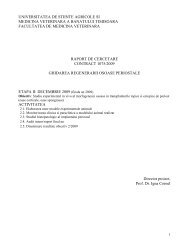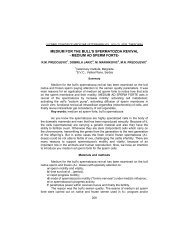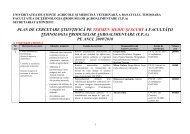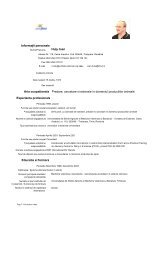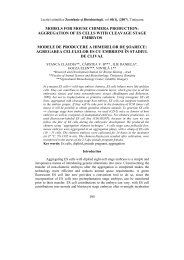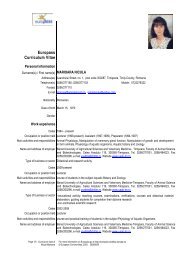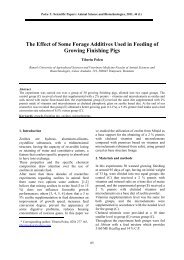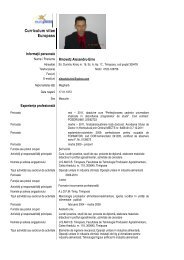Animal Science and Biotechnologies, 2011, 44 (2)
Animal Science and Biotechnologies, 2011, 44 (2)
Animal Science and Biotechnologies, 2011, 44 (2)
Create successful ePaper yourself
Turn your PDF publications into a flip-book with our unique Google optimized e-Paper software.
Negrea O. et. al./Scientific Papers: <strong>Animal</strong> <strong>Science</strong> <strong>and</strong> <strong>Biotechnologies</strong>, <strong>2011</strong>, <strong>44</strong> (2)<br />
- in meckerel species (comber scombrus)<br />
dominates low infestations (<strong>44</strong>,4%),<br />
followed by those medium (33,3%) <strong>and</strong><br />
high (22,2)<br />
- in herring species (Clupea herengus),<br />
medium infestations (46,1%) are<br />
dominant, followed by those with high<br />
level (30,7%) <strong>and</strong> low (23,1%)<br />
Table 2. Infestation intensity with Anisakis sp larva in marine fish, on species<br />
Species<br />
From which<br />
Number of<br />
Low infestation Medium infestation High infestation<br />
positive<br />
Number of<br />
Number of<br />
Number of<br />
samples<br />
%<br />
%<br />
%<br />
samples<br />
samples<br />
samples<br />
Mackerel 9 4 <strong>44</strong>.4 3 33.3 2 22.2<br />
Herring 13 3 23.1 6 46.1 4 30.7<br />
Total 22 7 31.5 9 40.9 6 27.2<br />
In the next graphic there are are presented<br />
percentage values in anisakiosis intensity of<br />
parasitism in larval marine fish sample taken in<br />
the study<br />
Anisakiasis in marine fish is a disease with a<br />
nonspecific clinical picture, insignificant. Man,<br />
however, can become accidental hosts after<br />
consumption of raw or undercooked fish in heattreated<br />
condition.[1, 2, 3, 4, 6]. Most sources of<br />
infestation for humans are given the traditional<br />
dishes of raw herring (Lomi-Lomi), salmon<br />
(ceviche, sushi, sashimi). Unfortunately, in<br />
humans the disease is extremely severe clinical<br />
picture expressed by an acute allergic syndrome<br />
(nausea, vomiting, abdominal cramps) <strong>and</strong>/or<br />
chronic enteral syndrome (subocclusions <strong>and</strong><br />
intestinal occlusion) whose only treatment is<br />
surgical.[7, 8, 9].<br />
50<br />
40<br />
30<br />
20<br />
10<br />
0<br />
<strong>44</strong>,4<br />
23,1<br />
31,5 33,3 46,1<br />
40,9<br />
22,2<br />
30,7 27,2<br />
Low inf. Med. inf. Massive<br />
inf.<br />
Mackerel Herring Total<br />
Figure 2. Percentage values in anisakiosis intensity of parasitism in larval marine fish<br />
C. Regarding the pathological table, most lesions<br />
are confined to the gut, <strong>and</strong> other locations are<br />
possible. These consist of:<br />
- intestinal mucosal congestion<br />
- lesions of hemorrhagic enteritis <strong>and</strong> necrotic<br />
hemoragic in focus, especially in heavy<br />
infestations when larvae are encysted [1, 2]<br />
- degenerative liver <strong>and</strong> renal lesions characterized<br />
by the presence of nodular foci <strong>and</strong> white rings on<br />
the surface <strong>and</strong> deep<br />
- the presence of cystic larval forms, located on<br />
the serosal bowel, gonads, in the form of nodules<br />
3-4 mm with a perifocous fibroconjunctival<br />
reaction.[3].<br />
37



